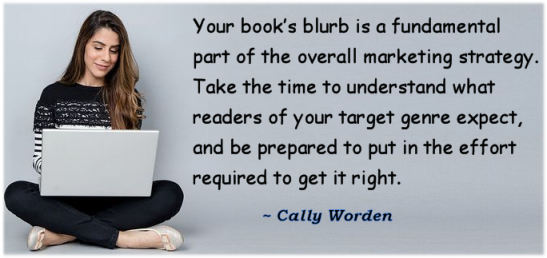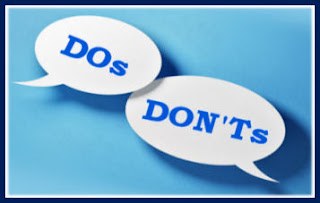Hello everyone, Winnie Griggs here.
Today I want to speak to you about writing a book blurb,
sometimes called back cover copy, for your book. I never paid a lot of
attention to what went into one until I dipped my toes in the self-publishing
pool and had to write the blurb myself. The first thing I discovered was that
it was hard! At least for me. So ever since then I’ve been studying them
and reading articles and tips on how to write them and I thought I’d share a
little of what I’ve learned. To do the subject justice, I’m going to do this in
two posts. Today we’ll cover what it is, why it’s important and some DOs and DON’Ts
What Is A Book
Blurb
Just so
everyone is on the same page, let me explain what I mean by a book blurb. For
the purposes of this post, the book blurb is the short book description you
find on the back cover or inside jacket of books you purchase. For an e-book
it’s the book description you find front and center on the book’s main page on
seller websites.
Why Should You
Care
The purpose of
a book blurb is to function as a marketing tool or sales pitch. They’re used to
attract and entice the reader into purchasing the book. In most cases, the
blurb is second only to the cover in what a potential reader uses to make a
buy/don’t buy decision. As such, it needs to really be engaging.
So how do you accomplish all of that in such a small word count?
Here are some DOs and DON’Ts. (And keep in mind – THIS IS ONLY MY OPINION. Feel free to disagree if you have found something else that works better for you)
·
Don’t
confuse your blurb with a synopsis. You don’t want to focus on the plot or try
to summarize your entire story. Instead you want to focus on the characters and
the emotional resonance of your story. Provide just enough information to intrigue
potential readers.
·
Don’t give up too much of your blurb space to
review quotes and accolades. Those can be placed elsewhere. The blurb is a
place to let the reader know what THIS BOOK is about.
·
Don’t
give away any spoilers. The reasons for that should be obvious, but it can be
tempting to show how clever you are with the twists and turns you take with
your story – resist! Find other ways to hook your reader enough to want to buy
the book and let them enjoy those surprises when they encounter them in the
story.
·
Don’t
forget to highlight the main conflict, the thread that will carry your story.
But do leave out the resolution of that conflict – again, no spoilers.
·
Do
keep it tight and punchy – a good rule of thumb is to shoot for 100-200 words
and to make use of both power words and words that evoke emotion.
·
Don’t
ignore the genre and tone of your book. Whether you are writing a thriller, a fantasy,
a romance, a women’s fiction, a cozy or anything else, the genre should be
clear from the word choices you use. Is it action packed, suspenseful,
humorous, spooky or dark? Reflect that in the tone of your blurb.
·
Do
make sure you understand the selling points of your story and then highlight
them.
·
Do
show what makes your book stand out from the crowd. How is your Marriage of
Convenience, Secret Baby, Second Chance Romance, etc. book different from all
the other books out there with the same trope? Find those aspects of your story
that are unique—be it the conflict, the character occupations, the setting or
something else—and highlight it.
·
Do
end with a strong hook—leave your reader with an irresistible urge to scoop up
your book to learn more
That wraps up
Part I. Next time we’ll do a deep dive into the components of a blurb and look
at some examples.
So do you have anything to add to my list of DOs and DON'Ts? Do you pay attention to a book's blurb when making a buy decision?
Leave a comment to be entered in a drawing for a book from my backlist.




Good post Winnie, and good start to a topic many of us don't think about until publication shows up on our doorstep. It is one of the nitpicky little chores of book publishing, along with the Dreaded Synopsis and "Comparables." It matters. It's one way to hook a reader, or at least interest them. I also read the inside cover copy and sometimes the first few paragraphs.
ReplyDeleteIt's an art, just like writing the book itself.
Probably won't be back, my daughter is sick, and I have to make a chicken soup run, everybody have a nice weekend.
Your Kaybee
Doing good works in New Hampshire
Hello Kaybee. So sorry to hear your daughter is under the weather, but what a good mom you are to carry over some chicken soup! Hope she gets to feeling better soon
DeleteGood morning, Winnie! Such a great post! I'm looking forward to seeing the second half!
ReplyDeleteThis is what I've been wrestling with lately, this boiling down of my story to something succinct. So far, the way I understand it, there's
the PITCH (your story in 1-3 sentence)
the BLURB (your story in 1-3 paragraphs)
The SYNOPSIS (your story in 1-3 pages).
It seems to me that novelists choose to be novelists because they need a whole book to say what they need to say. Lol! This short stuff is HARD! I need all the help I can get! Thanks for sharing what you've learned, Winnie.
Hi Terri Lynn. That's such a great nutshell picture of these three selling tools. And yes, I find it sooooooo much harder to write short than to write long. It's like that famous Mark Twain quote "I didn't have time to write you a short letter, so I wrote you a long one.” :)
DeleteThese are all just excellent points Winnie. Blurbs are tricky and I've found I need to just write them out best I can, and then start tightening, revising, strengthening word choices. But this list lays it all out just right. Thank you.
ReplyDeleteHello Mary. Thanks! And I've been known to use that method as well :)
DeleteThank you for this, Winnie!
ReplyDeleteAs I'm dipping my toes into the Indie publishing pool, writing the blurb is the next thing on my to-do list. You're timing is excellent!
Thanks Jan! Glad my timing is on point for once :) And I hope these posts will help you with this difficult-for-me topic
DeleteWinnie, this is all true and you are a sage. These are so hard to write sometimes. And I agree with Mary and Jan. Great timing and great advice!
ReplyDeleteHi Ruthie. LOL on my being a sage. As I said before, most of the topics I explore for these posts are to help me learn something I'm weak in.
DeleteWinnie, this is so good. I'm good at making a short story long, but not so much when it's the other way around. I'm printing this out.
ReplyDeleteGood afternoon Mindy. Thanks and I think there are many of us out there who feel the very same way!
DeleteThe shorter and more pithy something has to be, the harder it is to write! Gimme lots of words and space to ramble! Writing blurbs is hard!
ReplyDeleteAmen Erica!! Well said.
DeleteI always read book blurb before reading a book. If the cover and blurb draw me in then I will read it. Thank you for sharing Winnie. Blessings
ReplyDeleteHi Lucy - thanks for stopping by! And thanks for sharing your thoughts
DeleteWelcome today. I do read the blurbs and yes manytimes they do help me decide if I want to go further in looking into that book. The cover also helps. I have picked up books where the blurb sounds fabulous, the cover is nothing special and the book was so not clean. Opps. I know you take what you say to heart. I can tell by reading your wonderfully fabulous books. Just finsihed: A Matter Of Trust This was fabulous. Thank you. quilting dash lady at comcast dot net
ReplyDeleteHello Lori. Thanks so very much for those sweet words about my book - you made my weekend!
DeleteHi Winnie, this is a great post, can't wait to read the 2nd half. When choosing books I always look at the cover, turn the book over and read the blurb. Blurbs sell books! Blessings to you!
ReplyDeleteHi Karen. "Blurbs sell books" - so very true!
DeleteThis comment has been removed by a blog administrator.
ReplyDelete